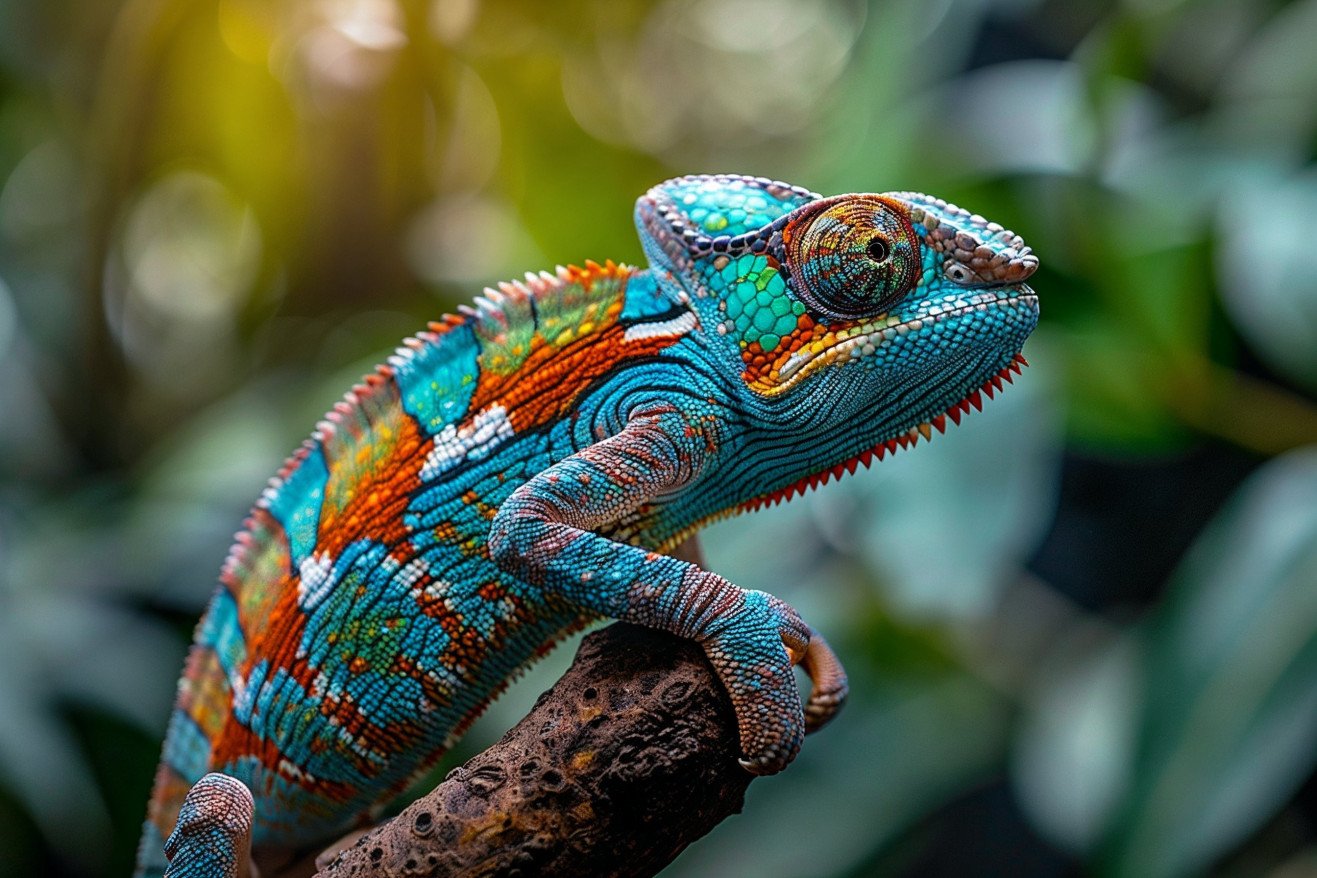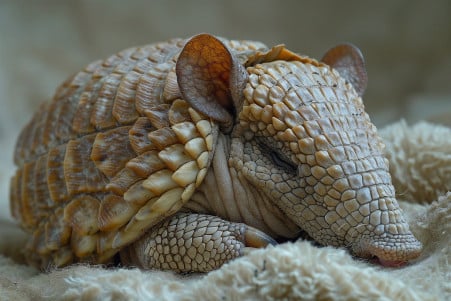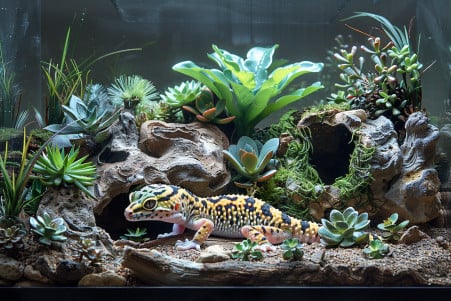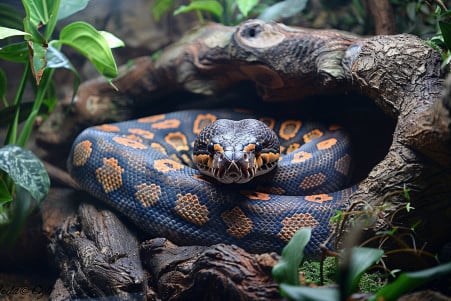Should You Get a Pet Chameleon? What to Know Before You Buy
18 March 2024 • Updated 17 March 2024

Chameleons are known for their color-changing abilities, but are they as interesting as pets? Chameleons are a pet with specific needs, including a specialized enclosure, live food, and a certain way of being handled. While they are beautiful, chameleons are not recommended for first-time reptile owners because they need a lot of attention. Instead, they are best for experienced reptile owners who want a pet they can observe more than handle.
This article will cover a variety of research from the fields of zoology, veterinary science, and environmental science to give you a complete understanding of what it takes to own a chameleon. We will cover everything from their health requirements and how long they live to how they breed and the environmental impact of the chameleon pet trade.
By the end, you will have a well-rounded view of whether or not a chameleon is a good fit for you and your family.
Should you get a pet chameleon?
Setting Up the Perfect Chameleon Enclosure
Chameleons need enclosures that are as close to their natural habitats as possible. The Spruce Pets explains that a chameleon’s enclosure should be large, at least 3 × 3 × 4 feet, and allow for the vertical movement that chameleons need to be healthy. Climbing branches, live nontoxic plants, and a basking area are all important, as is a high perch that will allow them to live an arboreal life.
Temperature control is also important, and some chameleons, like the veiled chameleon, have very specific temperature needs.
Chameleons have very specific dietary requirements. According to Allan’s Pet Center, chameleons are insectivores and eat a diet that’s primarily made up of live insects. These insects need to be gut-loaded with calcium and dusted with supplements to make sure that the chameleon is getting all of the nutrients that it needs. Chameleons also drink water from droplets on leaves, so regular misting is important.
In addition to keeping their enclosures clean, chameleons need to be misted regularly, their temperatures need to be monitored, and their enclosures need to be checked for signs of stress. The Spruce Pets also notes that there are several pieces of specialized equipment that are considered essential, including UVA/UVB lighting, thermometers, and humidity gauges. Chameleons also need to have access to a vet who specializes in reptiles in case they get sick.
Despite what many people think, chameleons are not easy pets to care for. They require a significant investment in both equipment and time to make sure that their needs are met. However, it’s essential to make sure that they are well cared for so that they don’t experience stress, especially since they are solitary animals. This is important for their overall health and well-being.
Caring for a Chameleon: How to Avoid Common Health Problems
Chameleons kept in captivity are prone to several health problems, with Metabolic Bone Disease (MBD) and respiratory infections being the most common, according to The Spruce Pets. Since chameleons are so good at hiding their symptoms, it’s important for owners to know what to look for in terms of the more subtle signs of health problems.
For instance, Chameleon Academy explains that by the time a chameleon shows symptoms, the disease may be too far along to treat, which is why early detection is so important.
In addition to regular veterinary visits, which should happen every 6 to 12 months, according to Pets on Mom, it’s also important to keep your chameleon’s stress levels low. A stressed chameleon is more likely to get sick because their immune system is weakened. Keeping their environment low-stress, feeding them a healthy diet, and keeping their enclosure clean can all help prevent common chameleon health problems.
It’s also important to make sure that you keep your chameleon’s habitat clean to prevent illness. If you notice that your chameleon is showing signs of illness, such as a lack of appetite, dull color, or sunken eyes, as listed by The Spruce Pets, it’s important to get them to the vet right away.
Catching and treating an illness early can make all the difference in your chameleon’s recovery. By being proactive and attentive, you can help ensure that your pet chameleon lives a long and healthy life.
Factors That Affect Chameleon Lifespan in Captivity
The lifespan of chameleons in captivity varies, with larger species like the Parson’s and veiled chameleons potentially living for 10 years or more and smaller species having much shorter average lifespans. According to Pets on Mom.com, captive-bred chameleons can live longer than their wild counterparts with proper care, including a good diet, UVB lighting, and supplementation.
Chameleon breeders have even more to consider, especially when it comes to the care of female chameleons that are used for breeding. According to the Chameleon Academy, the process of egg production can take a toll on female chameleons and shorten their lifespans significantly compared to males. For example, female panther chameleons live for 3–5 years, while males live for 5–7 years.
In order to ensure a chameleon has a good life in captivity, their habitat must be carefully managed to reduce stress and meet their dietary needs based on their species.
In addition, breeders must make sure they are breeding chameleons ethically to avoid overbreeding and to make sure the parents and offspring are well cared for. Owners should see these factors as equally important and weigh their decisions carefully based on how they will affect the chameleon’s health and the health of the species.
The Ecological Footprint of Chameleon Pet Ownership
Yet, the popularity of chameleons as pets has come with a steep environmental price.
Research from Virginia Commonwealth University shows that chameleon populations in Tanzania’s montane rainforests have dropped by more than 60 percent because of habitat loss and fragmentation.
This has led to a troubling pattern in which exotic pet traders are capturing chameleons and further threatening their wild populations. Meanwhile, in Madagascar, where the majority of these reptiles are found, more than half of the island’s native chameleon species are at risk of extinction, and the pet trade is one of the main reasons why, according to the IUCN’s Chameleon Specialist Group.
Scholars have started to question the sustainability of keeping chameleons as pets and have suggested captive breeding as a way to relieve the pressure on wild populations.
However, the fact that so few chameleons, such as the Parson’s chameleon, are successfully bred in captivity shows just how difficult this would be to pull off.
This makes it all the more important for pet owners to make sure they are responsible, with a focus on preserving biodiversity and ecosystems. As people grapple with the moral implications of getting a pet, it’s important that they think about the impact on chameleons around the world, which can be better understood by looking at the research on habitat loss and the pet trade.
Legal and Ethical Considerations of Chameleon Ownership
Owning a chameleon comes with a host of legal and ethical considerations. For example, in California, the California Department of Fish and Wildlife lists permits that are required for certain species, including the Veiled, Panther, and Jackson’s chameleons, to protect the state’s ecosystems and the species themselves.
In addition, the Convention on International Trade in Endangered Species (CITES) has listed most chameleons on its Appendix II, which means there are specific regulations in place to prevent them from being taken from the wild.
Ethical considerations go beyond the law to include the well-being of the chameleons and the impact of keeping them in captivity. As My Pet Chameleon points out, potential owners should ask for CITES paperwork to ensure that the chameleons they are considering purchasing are not wild-caught. They should also seek out captive-bred chameleons to help take the pressure off of wild populations and promote sustainability.
For people who are thinking about breeding chameleons, "Much Ado About Chameleons" emphasizes the importance of ethical breeding, which includes prioritizing the well-being of the animals and not flooding the market with chameleons. "Much Ado About Chameleons" also notes that responsible breeders will make sure they have appropriate homes lined up for all of the chameleons they breed and will contribute to conservation efforts.
Potential owners need to make sure they are following the law and acting ethically by adhering to regulations and considering the well-being of the animals and their natural habitats. This conscientious approach to chameleon ownership helps ensure the conservation of the species and the integrity of the exotic pet industry.
Chameleons as Pets: A Recap of What to Know
In this article, we have covered the many nuances of chameleon care, from their specific housing and environmental needs to their special diets and the importance of careful monitoring for potential health problems.
We have also discussed the time and effort it takes to ensure their well-being, including the role we play in their breeding and the challenges that come with it, especially for female chameleons.
We have even looked at the larger context of chameleon care, including the impact of the pet trade on the environment and the ethical questions that come with the decision to care for these incredible animals.
Given the many nuances and demands, it’s safe to say that chameleons are not low-maintenance pets. They require a lot of time, money, and effort. As a result, potential owners need to do their due diligence and make careful choices to ensure their chameleons are healthy and happy.
Responsible pet ownership is important not just for the animals themselves but also for the broader goals of preserving biodiversity and protecting ecosystems. Therefore, helping to ensure the survival of the species in the wild is a crucial aspect of caring for chameleons.


